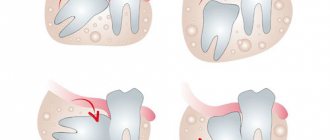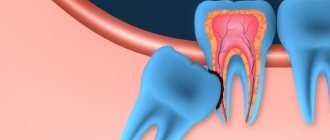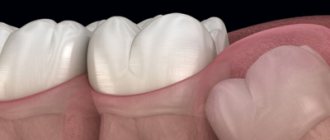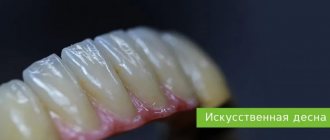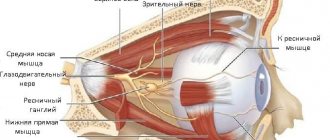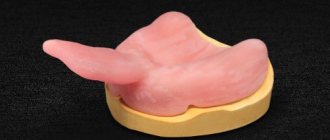The importance of prosthetics
The main reason for refusals to install dentures is associated with the erroneous opinion of old-school dentists about the mandatory depulpation (removal of the nerve) of teeth before prosthetics. Before dispelling this myth, it is necessary to recall the importance of timely prosthetics.
Without an adequate prosthesis, neighboring healthy teeth begin to carry an unusual load, which leads to their increased wear, mobility and early loss. In addition, in the absence of even one tooth, speech defects appear, chewing functions are disrupted, bite pathologies occur, and even facial proportions are distorted.
Reasons for installing a crown without removing the nerve
To preserve the tooth, dentists try to maintain blood supply and innervation. After removing the nerve, the enamel is quickly destroyed, exposed to external influences, and caries appears. Whenever possible, the tooth is left alive.
Cases of crown installation without pulp removal:
- destructive gum diseases that lead to loose teeth;
- grinding of teeth located next to problem ones for further installation of crowns, bridges, clasp dentures;
- partial destruction of the crown as a result of mechanical trauma;
- installation of veneers for aesthetic purposes;
- the tooth has changed color and is very different from the others;
- destruction is less than 50%.
Please note: Sometimes patients complain that after installing a crown on a living tooth, pain and swelling of the gums remain. These symptoms are not directly related to the procedure. The main causes of negative consequences are the abnormal location of the channels. Violations of the preparation technique are observed less frequently.
Causes of frequent depulpations
Why do orthopedists so often remove pulp from teeth? The main reason lies in the desire of doctors to play it safe and avoid complications after prosthetics. The fact is that teeth have a porous structure. Pores are dentinal canals that run from the enamel to the pulp of the tooth. During grinding of teeth for a crown, mechanical irritation of the pulp may occur through these dentinal canals.
And at the last stage of fixing the prosthesis, there is a toxic effect of cement. And as a result - infection and death of the pulp. However, this does not allow us to consider depulpation as a prevention of complications, since this procedure is inevitably associated with the risk of developing periodontal pathologies. After all, no one suggests removing the appendicitis for preventive purposes. Living teeth retain their stability much longer.
Whereas teeth subjected to depulpation become extremely fragile and are more susceptible to destruction, losing their shock-absorbing function.
Is it necessary to depulpate all teeth for crowns?
One of the main questions is whether it is necessary to depulpate a tooth (remove the nerve) if it is planned for a crown? A huge number of patients, what about patients, even dentists are still convinced that teeth under a crown must be depulped!
This is wrong! YOU DO NOT NEED TO DEPULPATE YOUR TEETH UNDER CROWNS! Moreover, it is criminal. A living tooth is much more physiological than a dead one, it will live longer and can endure more than one crown change. In addition, if the tooth was killed without proper indications, the patient can also sue for moderate mutilation. Sometimes there are indications for this (incorrect position of the tooth, as a rule), but they are few.
A dead tooth is always a risk of complications after canal filling and an organ weakened by fillings. To remove the pulp, most of the enamel and dentin are removed, leaving a large filling in the middle with thin walls of the tooth on the sides, which the doctor will also remove when processing it for a crown. So what remains? Not much.
Even according to the best statistics, pulpless teeth survive on average from five to fifteen years. And if the doctor fails to properly fill the canals and find all the branches from them, then even less.
A living tooth is always better! However, there are clear conditions. In order for the tooth to survive the treatment, several rules must be followed. We will give only three main ones.
- Tooth processing must be carried out strictly with water cooling, otherwise you will inevitably get a burn to the pulp. The presence of a saliva ejector and a vacuum cleaner requires mandatory four-handed work with an assistant (otherwise there will simply be no one to hold these tools). Considering that in our country many district clinics still have six chairs per nurse in their office, normal treatment in this case is almost impossible.
- Tooth processing should be carried out only with new burs. Old “bald” burs do not so much process the tooth as overheat it and can also cause burns to the pulp. If the clinic saves on burs and gives the doctor two burs for six months, then you can forget about living teeth.
- Immediately after treatment, the doctor must make and place a temporary crown on the living tooth. Otherwise, the patient will experience extremely unpleasant sensations due to pain, and the dental pulp will be exposed to thermal and chemical effects from the oral cavity, which can lead to chronic pulpitis. If the doctor thinks that temporary crowns are a hussar and a waste of time, then you will not see a living tooth after treatment.
Apologists of the ancient theory that “the tooth under the crown must be depulped”, as a rule, have only one argument. What if then the living tooth under the crown hurts and all the work will have to be redone.
You don’t have to, not all of it! We won't talk about long bridges. This is yesterday. If you do not abuse them, but do it as it should be according to the rules for uniting teeth, then at most a diseased tooth will require alteration of one or two crowns, no more.
Pulpitis is usually detected in the first six months. Any non-removable orthopedic structure has a minimum one-year warranty. Rework is carried out under warranty. The patient pays only for endodontics, for which he would have paid anyway if he had followed the rule of pulp removal before prosthetics.
Therefore, the doctor who sends you for depulpation immediately is simply not confident in his work and does not want to redo the crown later at his own expense.
Statistics suggest that complications after treatment occur in less than 1% of cases.
Well, at the same time, consider what is more profitable for the patient? Should I take a risk within one percent and leave all my teeth alive, or be sure to destroy all the nerves in all my teeth so as not to risk it? At the same time, knowing for sure that pulpless teeth, according to statistics, live several times less!
That is why we urge both doctors and patients not to depulpate teeth before prosthetics.
And there is no charity or self-interest in this. Only science, high-quality work and accurate calculations.
Knowledge and experience of orthopedists
Of great importance in the issue of prosthetics without depulpation is the knowledge of orthopedic doctors about the safety zones of the crown parts of teeth. Safety zones are those areas of the tooth within which you can safely grind the tooth tissue without damaging the pulp.
The canines have slightly more such tissue than the lateral incisors. The age of the patient is also important: the older the person, the less likely the pulp is to be damaged.
Contact our clinic for a consultation on prosthetics without depulpation, and we will definitely find the right solution for you!
Dental prosthetics in our clinic. Types of dental crowns and methods of their manufacture
Indications for pulp removal
An informed decision about pulp removal is the last step before installing a crown. Specialists rely heavily on dental experience. The patient’s reputation and health come first, so no one will install an expensive crown and then remove it later.
In what cases is the decision to remove a nerve made?
- advanced caries;
- pulpitis;
- partial exposure of the nerve when grinding the enamel;
- tooth injury resulting in nerve damage;
- hypersensitivity;
- anatomically incorrect tooth structure;
- low landing of the crown.
In the vast majority of cases, depulpation can be avoided if the dentist is fluent in preparation techniques. Prosthetics on living teeth is preferable.
Recommended material for a crown on a living tooth
The choice of material depends on which teeth the crown will be installed on. High-quality dentures look more aesthetically pleasing and will last longer, so there is no need to save on cost.
- Metal ceramics. Modern dentistry rarely uses this material due to the need to remove a thick layer of enamel. Doctors prefer metal-free structures for prosthetics of a living tooth and after depulpation.
- Ceramics. Ceramic crowns are difficult to distinguish from natural teeth. They are light and imperceptible to use. Suitable even for allergy sufferers. Ceramic crowns are not placed on chewing teeth.
- Zirconium dioxide. Strong and durable material that lasts up to 20 years. Its cost is slightly more expensive than ceramics, but zirconium dioxide is indispensable for back teeth.
The dental clinic "Carmen-Med" in Nizhny Novgorod specializes in prosthetics of any complexity. Already at the first consultation, the doctor will draw conclusions about the need to depulpate or preserve the nerve before installing a crown.
Installation
Before installing a crown, you need to remove tartar and plaque, and treat caries on nearby teeth.
Prepare the tooth itself for installation, treat caries if necessary.
In the absence of the required volume of tissue, the installation of a pin and the installation of a stump pad are required.
This is followed by gentle grinding of the tooth with a drill. The procedure is performed under local anesthesia. Afterwards, an impression is made or a digital copy of the tooth is scanned. This cast/copy is sent to the laboratory, and a specialist creates a prosthesis based on it. If we scan using CEREC technology
, then the doctor begins making the crown literally in 20 minutes, see video:
The finished product is tried on and adjusted if necessary before installation.
If there is a delay in production, then in order to cover the ground tooth, since aesthetics suffer and sensitivity increases, plastic dentures are offered.
Installation steps
So, the crown is made, all that remains is to try it on and install it. The dentist, putting on a crown, asks whether it hurts or not?
If not, then fix the crown with special temporary cement. All that remains is to wait 30 days to make sure that the patient does not have an allergy and that the closure of the teeth in the area where the crown is installed is normal.
After this, at the next appointment at the clinic, the remaining cement is removed, the denture is placed on a stronger composition, permanent cement, and it can only be removed by sawing it in parts.
Methods for removing the nerve of a tooth
Today, the depulpation procedure is not limited to one method and can be performed in two ways, depending on individual indications.
Vital method of tooth nerve removal
With this method, the “living” nerve is removed, and thanks to local anesthesia, the patient does not feel pain during this treatment. The advantage of this method is that the nerve is removed in one visit to the dentist. After administering anesthesia, the doctor “removes” the area of the tooth affected by caries, then the nerve is removed, after which a permanent filling is installed on the tooth. Vital depulpation is possible for both adults and children.
Devital method of tooth nerve removal
This method involves the complete removal of the “dead” nerve from the crown and root part of the tooth. It takes longer than the vital. First, under anesthesia, the doctor “removes” the area of the tooth affected by caries, then a special paste is applied to the pulp to kill the nerve. After this, a temporary filling is placed. On the second visit, the nerve is completely removed, and a permanent filling is installed in place of the temporary filling.
Today, the vital method of nerve removal is more common in dentistry due to its speed and efficiency. However, in some cases, if there are indications, the devital method of depulpation is more applicable for the patient. The removal method is determined by the doctor based on the results of an x-ray examination.
How is the tooth nerve removal procedure performed?
For most people, the fear of removing the nerve of a tooth comes from the times when dentistry was not yet as developed as it is today. Many people remember that previously this operation was performed with the help of arsenic, which made it possible to “kill” the nerve. But depulpation in this way had two significant drawbacks:
- Danger of tooth decay due to prolonged exposure to arsenic;
- Extremely painful sensations during the procedure.
Fortunately, all this is a thing of the past and today dentists have managed to achieve the optimal combination of treatment effectiveness and patient comfort when removing the nerve.
How is tooth nerve removal done in modern dentistry? The key difference is that safe arsenic-free agents are used to remove the pulp, as well as high-quality local anesthesia. Depulpation can be done in one visit to the dentist, with minimal discomfort during the procedure and a quick recovery period.
Why cover a pulpless tooth with a crown?
When a patient who came to just get a filling hears from the dentist that it is recommended to cover the tooth with a crown, he is overcome with horror! After all, a crown is already an adult thing, it is no longer just a filling or restoration, in its essence it is already a prosthesis. And what kind of prosthetics can we talk about if “I just came to get a filling”? And sometimes the patient decides to consult with another doctor who offers the same thing, and then with another, and another, and another, in the hope of hearing that the tooth can simply be treated without a crown.
But things are not so simple here. If the doctor recommends covering a tooth with a crown, there are definitely indications for this. In this article we will not consider all cases. Let us touch upon only one of the most common cases - covering a pulpless tooth with a crown.
A pulpless tooth is a tooth in which the pulp (nerve) has been removed. Such a tooth is also called dead (devitalized). In addition to the nerve, the pulp also includes blood and lymphatic vessels and connective tissue. It is through the pulp that the tooth receives nutrients that provide its regenerative abilities, which a pulpless tooth does not possess at all.
The lack of regenerative abilities significantly reduces the life of a tooth. Without internal nutrition through the pulp, the tooth becomes extremely fragile. For clarity, a pulpless tooth can be compared to a dry tree - outwardly, both can have a very solid and impressive appearance, but be hollow and brittle inside.
The main risk associated with such tooth fragility is fracture or chipping. And in the case of a tooth deprived of nutrition (internal support), such chips are, as a rule, very deep, often extending under the gum. And in the case when the fracture line or chip of the tooth goes deep under the gum, it is no longer possible to restore such a tooth reliably and for a long time either with a filling or with a crown. And this is with a favorable outcome, if the tooth can, in principle, be saved after such a fracture.
But a pulpless tooth is not a death sentence at all! Yes, theoretically it can be a time bomb, but with the right approach, a pulpless tooth can last a very long time.
A competent approach in the case of a pulpless tooth includes 2 aspects:
- thoroughly treated and sealed root canals;
- mandatory (!) covering of a pulpless tooth with a crown.
The crown will protect the entire structure of the tooth (roots and remains of its coronal part) from further chipping and destruction, thereby maximizing its life, despite the actual non-viability of the pulpless tooth.
Therefore, if it so happens that you have to deal with the removal of nerves in a tooth, be sure to listen to your dentist’s recommendations regarding covering it with a crown. This is not a whim at all, but a mandatory condition for maintaining the integrity of the dentition.
Modern dentistry offers a lot of options for crowns: from the most popular metal-ceramic to the most highly aesthetic ceramic ones, the many varieties of which we will definitely talk about in one of the following articles.
Take care of your teeth and be healthy!
0
